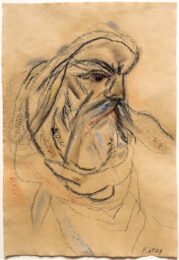

1932-2007
R.B. Kitaj was born in Cleveland, Ohio, USA. He enjoyed an extensive period in academia during the 1950s, first studying at the Cooper Union for the Advancement of Science and Art, New York from 1950-51, then returning in 1952. He spent time in the Merchant Navy in 1951 also attending the Academy of Fine Art, Vienna. Kitaj then went on to the Ruskin School of drawing in Oxford in 1958-9, and the Royal College of Art from 1959 to 1961. Kitaj recalled: “It was at the Royal College where, in the first week, I began my constant friendship with the amazing Hockney.”
He immersed himself in all aspects of artistic living – being equally profound through his particular aesthetic style, and through his literal analytic accomplishments of manifesto writing (First Diasporist Manifesto 1989, Second Diasporist Manifesto 2007.)
Tracing Kitaj’s philosophical motivations and commitments, Alex Danchev writes that “Kitaj apprenticed himself early to what he called ‘the primacy of artistic craziness’: passionate commitment, deep immersion, fierce self-scrutiny. His career is a monument to the dedicated artist-life. He grew crazier with each passing year.” (100 Artist’s Manifestos, Danchev, 2011).
In 1958, Kitaj had his first group exhibition ‘Young Contemporaries’ at RBA Galleries, London. He was then included in a further thirteen group exhibitions within Europe and beyond, including John Moore’s Liverpool exhibition 3 years in a row, before holding his first one-man exhibition at Marlborough Fine Art, London in 1963.
He taught at various prestigious intuitions, including University of California Berkeley 1967-8, University of California Los Angeles in 1970-1. In 1972 he returned to London. His 1983 marriage to the American artist Sandra Fisher (1947-94) is celebrated in his paintings Cecil Court, London WC2 (The Refugees) (Tate Gallery T04115) and The Wedding (Tate Gallery T06743).
In 1976 Kitaj selected for the Arts Council of Great Britain a group of British works, connected by a common theme, which formed the core of an exhibition called ‘The Human Clay’. The show included works by Bacon, Freud, Auerbach, Kossoff, Moore, Hodgkin, Hockney, Kitaj himself, and others. Kitaj’s essay for the catalogue, in which he proposed the idea of a School of London, became one of the key art historical texts of the period. In 1989 he published the First Diasporist Manifesto, the longest and most impassioned of his many texts discussing the Jewish dimension in his art and thought.
Across his career he was included in 7 Biennials, 47 solo shows, and more than 200 group shows.
His various honours include election to the American Academy of Arts and Letters in 1982. In 1985 he became the first American since Sargent to be elected to the Royal Academy. Numerous retrospective exhibitions of his work have been held, including shows at the Hirshhorn Museum, Washington, DC and tour 1981-2; and the Tate Gallery, Los Angeles County Museum of Art and Metropolitan Museum of Art, New York 1994-5. He received no less than 5 honorary doctorates from Spertus College, Chicago, Durham University, Stochton-on-Tees, California College of Arts, Oakland, Royal College of Art, London, and University of London, London,
He moved to Los Angeles in 1997.